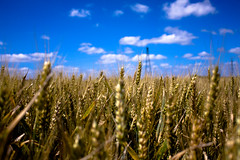Chapter 10 Vocabulary for AP Biology
| 9431990529 | Chlorophyll | Green Pigment Main photosynthetic pigmnet Absorbs primarily violet-blue and red wavelengths |  | 0 |
| 9431990530 | Thylakoids | dense interconnected membranous sacs where the light reactions occur |  | 1 |
| 9431990531 | Grana | stacks of thylakoid | 2 | |
| 9431990532 | Granum | singular of grana | 3 | |
| 9431990533 | Chloroplast | sites of photosynthesis | 4 | |
| 9431990534 | Photosynthesis | conversion of light energy into chemical energy stored in sugar and other organic molecules |  | 5 |
| 9431990535 | Photosynthesis Equation | 6 CO2 + 6 H2O + light --> C6H12O6 + 6 O2 | 6 | |
| 9431990536 | Carbon Dioxide | source of inorganic carbon used in photosynthesis | 7 | |
| 9431990537 | Electromagnetic Spectrum | Electromagnetic energy which travels in waves |  | 8 |
| 9431990538 | Colors | Light we see is reflected off objects and light we don't see is absorbed by objects | 9 | |
| 9431990539 | White | All colors reflected | 10 | |
| 9431990540 | Black | All colors absorbed | 11 | |
| 9431990541 | Chlorophyll a | main photosynthetic green pigment, absorbs primarily violet-blue and red wavelengths | 12 | |
| 9431990542 | Pigment | a molecule that absorbs wavelengths in the visible light spectrum | 13 | |
| 9431990543 | Carotenoid | Group of pigments that absorb blue and blue-green wavelengths, appear orange, yellow, and red | 14 | |
| 9431990544 | Light Reactions | Occur in thylakoid membrane and are also called light dependent reactions | 15 | |
| 9431990545 | Photosystem | Consists of a reaction-center complex surrounded by light-harvesting complexes which split water to create electrons that get transferred to NADP+ to create NADPH and H+ which are used to create ATP | 16 | |
| 9431990546 | Light-Harvesting Complex | Contains chlorophyll a, chlorophyll b, and carotenoids (within the photosystem) that will trap light energy for use in the light reactions | 17 | |
| 9431990547 | Photosystem 1 | Has P700 chlorophyll a in reaction-center complex, thought to have evolved first because it can work alone to create primary acceptors, 2nd of the photosystems |  | 18 |
| 9431990548 | Photosystem 2 | Has P680 chlorophyll a in reaction-center complex, first of the photosystems. splits water into electrons, oxygen, and hydrogen ions | 19 | |
| 9431990549 | Cytochrome | Protein in the electron transport chain of the photosystems that transfers the electrons to create NADPH | 20 | |
| 9431990550 | Calvin Cycle | Light-Independent reactions Occurs in stoma, does not use light directly. Uses the enzyme Rubisco to create 2 molecules of G3P which is then either used to create glucose or recycled back into RuBP to restart the cycle |  | 21 |
| 9431990551 | Rubisco | The most abundant protein on Earth Carbon Fixation is catalyzed by Rubisco | 22 | |
| 9431990552 | Reduction | The carbon molecules made in Carbon Fixation are reduced into to G3P by adding the negative phosphate from a NADPH that can be used to make glucose or perform other processes | 23 | |
| 9431990553 | 1 Cycle of Calvin Cycle | 1 CO2 is fixed 3 ATP are used 2 NADPH are used 1 RuBP is regenerated 6 cycles needed to make 1 glucose molecule | 24 | |
| 9431990554 | C4 Photosynthesis | A method that bypasses photorespiration Happens in corn, sugarcane, and other plants in hot, dry environments Converts carbon dioxide to a 4-carbon intermediary which is then stored in bundle-sheath cells | 25 | |
| 9431990555 | C3 Plant | Plants that use the Calvin Cycle without creating carbon intermediaries, take in carbon dioxide through stomata. An enzyme called RuBisCO helps the carbon dioxide combine to make sugar. |  | 26 |
| 9431990556 | chlorophyll b | Pigment that absorbs light in the blue and orange light spectrum. Second major pigment used in plants. | 27 | |
| 9431990557 | CAM Plants | Plants that only open stomata at night. They convert carbon dioxide to malic acid which is then converted back into carbon dioxide during the day for the Calvin cycle | 28 |

